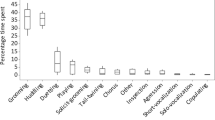Abstract
Members of the genus Colobus have been observed to associate frequently with Cercopithecus monkeys in several African sites. In the Taï National Park, Ivory Coast, one group of western red colobus was found to be in association with one particular group of diana monkeys more than could be expected by chance (Holenweg et al., 1996). We show that dyadic association is not an idiosyncrasy of these two groups, but rather a pattern that is general for our study site. All five red colobus groups we studied were closely associated with diana monkeys during more than 60% of the time. Four groups had one particular diana partner group, the fifth two different partners. Apart from the red colobus, three more primate species, the olive colobus, Campbell's monkey, and the lesser spot-nosed monkey, were also strongly attracted to diana monkeys.
Similar content being viewed by others
References
Bshary, R. 1995. Rote Stummelaffen,Colobus badius, und Dianameerkatzen,Cercopithecus diana, im Taï Nationalpark, Elfenbeinküste: Wozu assoziieren sie? Ph.D. thesis, Univ. of Munich, Germany.
Bshary, R.; Noë, R. in press. Red colobus and diana monkeys provide mutual protection against predators.Anim. Behaviour.
Cords, M. 1987. Mixed-species association of Cercopithecus monkeys in the Kakamega Forest, Kenya. Univ. of California Publ. in Zoology No. 117. Univ. of California Press, Berkeley.
Cords, M. 1990a. Mixed-species association of East African guenons: general patterns or specific examples?Amer. J. Primatol., 21: 101–114.
Cords, M. 1990b. Vigilance and mixed-species association of some East African forest monkeys.Behav. Ecol. Sociobiol., 26: 297–300.
Galat, G.;Galat-Luong, A. 1985. La communauté de primates diurnes de la forêt de Taï, Côte d'Ivoire.Rev. Ecol., 40: 3–32.
Garber, P. A. 1988. Diet foraging, patterns, and resource defense in a mixed-species troop ofSaguinus mystax andSaguinus fuscicollis in Amazonian Peru.Behaviour, 105: 18–34.
Gautier, J.-P.;Gautier-Hion, A. 1969. Les associations polyspécifiques chez les Cercopithecidae du Gabon.Rev. Ecol., 116: 164–201.
Gautier-Hion, A.;Quris, R.;Gautier, J.-P. 1983. Monospecific vs polyspecific life: a comparative study of foraging and antipredatory tactics in a community of Cercopithecus monkeys.Behav. Ecol. Sociobiol., 12: 325–335.
Heymann, E. W. 1990. Interspecific relationships in a mixed species troop of moustached monkeysSaguinus mystax and saddle-back tamarinsSaguinus fuscicollis, Platyrrhini: Callitrichidae, at the Río Blanco, Peruvian Amazonia.Amer. J. Primatol., 21: 115–127.
Holenweg, A.-K.;Noë, R.;Schabel, M. 1996. Waser's gas model applied to associations between red colobus and diana monkeys in the Taï National Park, Ivory Coast.Folia Primatol., 67: 125–136.
McGraw, W. S. 1994. Census, habitat preference, and polyspecific associations of six monkeys in the Lomako forest, Zaire.Amer. J. Primatol., 34: 295–307.
McGraw, W. S. 1996. Cercopithecid locomotion, support use, and support availability in the Taï forest, Ivory Coast.Amer. J. Phys. Anthropol., 100: 507–522.
Morse, D. H. 1970. Ecological aspects of some mixed-species foraging flocks of birds.Ecol. Monogr., 40: 119–168.
Moynihan, M. H. 1962. The organisation and probable evolution of some mixed-species flocks of neotropical birds.Smithsonian Miscellaneous Collections, 143 (7).
Noë, R.;Bshary, R. 1997. The formation of red colobus — diana monkey associations under predation pressure from chimpanzees.Proc. R. Soc. B., 264: 253–259.
Oates, J. F.;Whitesides, G. H. 1990. Association between olive colobus (Procolobus verus), diana guenons (Cercopithecus diana) and other forest monkeys in Sierra Leone.Amer. J. Primatol., 21: 129–146.
Peres, C. A. 1992a. Prey-capture benefits in a mixed-species group of Amazonian tamarins,Saguinus fuscicollis andS. mystax.Behav. Ecol. Sociobiol., 31: 339–347.
Peres, C. A. 1992b. Consequences of joint-territoriality in a mixed-species group of tamarin monkeys.Behaviour, 123: 220–246.
Rohlf, F. J.;Sokal, R. R. 1981.Statistical Tables (2nd ed.). Freeman, New York.
Smuts, B. B.;Cheney, D. L.;Seyfarth, R. M.;Wrangham, R. W.;Struhsaker, T. T. 1987.Primate Societies. Univ. of Chicago Press, Chicago.
Struhsaker, T. T. 1978. Food habits of five monkey species in the Kibale Forest, Uganda. In:Recent Advances in Primatology, Vol. 1,Chivers,D. J.;Herbert,J. (eds.), Academic Press, New York, pp. 225–248.
Struhsaker, T. T. 1981. Polyspecific associations among tropical rain-forest primates.Z. Tierpsychol., 57: 268–304.
Suhonen, J.;Alatalo, R. V.;Gustavsson, L. 1994. Evolution of foraging ecology in Fennoscandian tits (Parus spp.).Proc. R. Soc. B., 258: 127–131.
Suhonen, J.;Halonen, M.;Mappes, T. 1993. Predation risk and the organisation of the Parus guild.Oikos, 66: 94–100.
Terborgh, J. 1983.Five New World Primates: A Study in Comparative Ecology. Princeton Univ. Press, Princeton.
Terborgh, J. 1990. Mixed flocks and polyspecific associations: costs and benefits of mixed groups to birds and monkeys.Amer. J. Primatol., 21: 87–100.
Wachter, B.;Schabel, M.;Noë, R. 1997. Diet overlap and polyspecific associations of red colobus and diana monkeys in the Taï National Park, Ivory Coast.Ethology, 103: 514–526.
Whitesides, G. H. 1989. Interspecific associations of diana monkeys,Cercopithecus diana, in Sierra Leone, West Africa: biologial significance or chance?Anim. Behav., 37: 760–776.
Whitmore, T. C. 1990.An Introduction to Tropical Rain Forests. Clarendon Press, Oxford.
Author information
Authors and Affiliations
About this article
Cite this article
Höner, O.P., Leumann, L. & Noë, R. Dyadic associations of red Colobus and diana monkey groups in the Taï National Park, Ivory Coast. Primates 38, 281–291 (1997). https://doi.org/10.1007/BF02381615
Received:
Accepted:
Issue Date:
DOI: https://doi.org/10.1007/BF02381615




